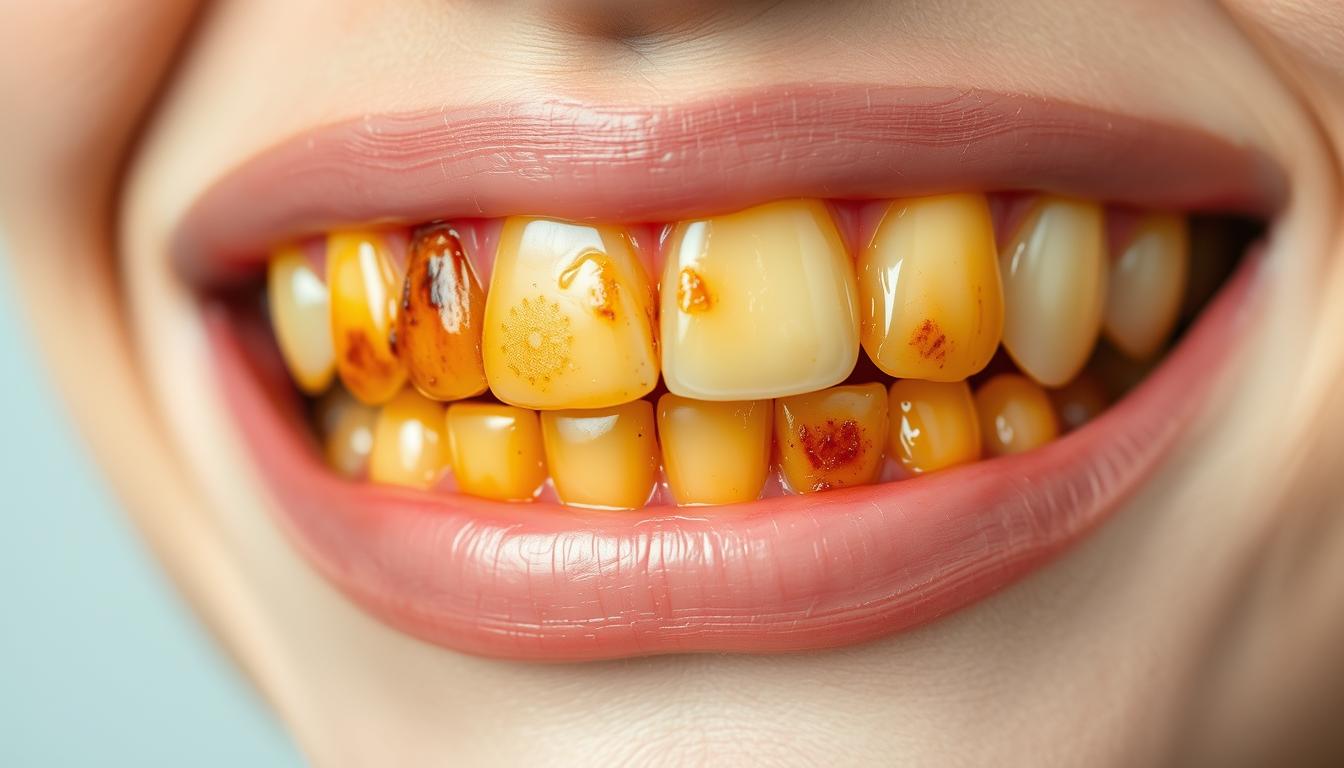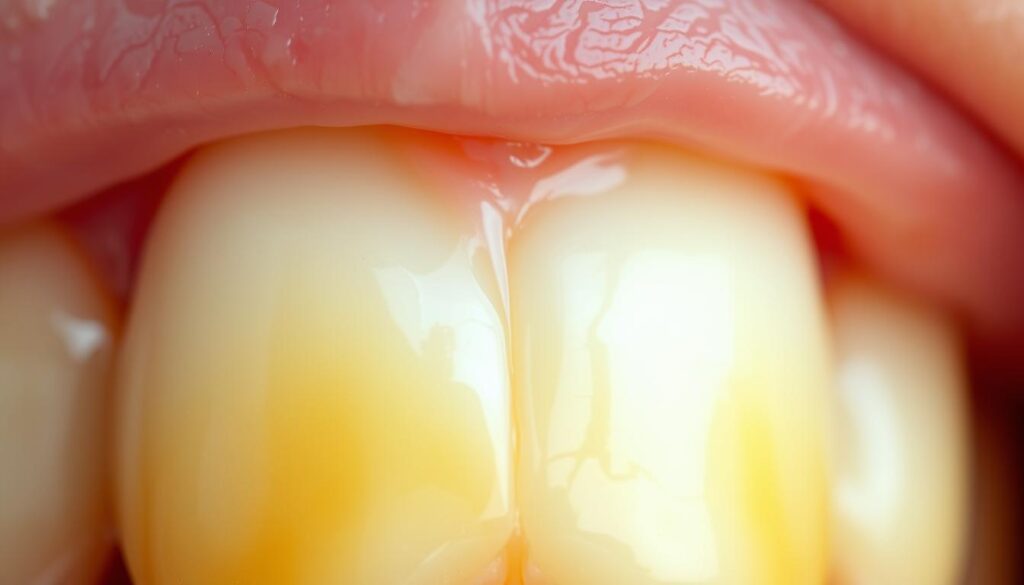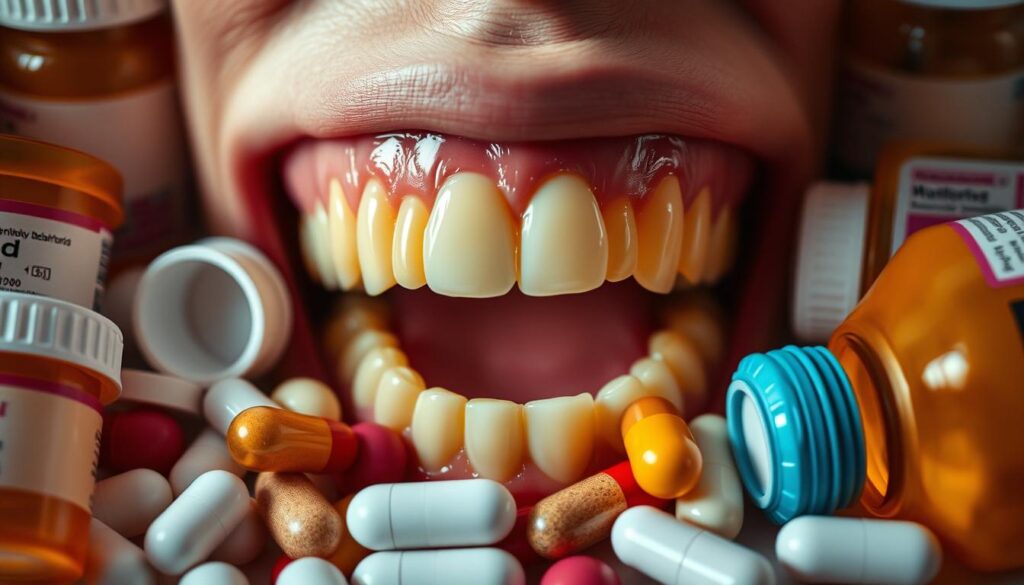October 9, 2024 lori
What causes yellow teeth

Tooth discoloration can make people feel self-conscious. This article will look at why teeth turn yellow. We’ll cover the main reasons behind this common problem. By understanding these causes, you can take steps to prevent yellow teeth.
Key Takeaways
- Tooth discoloration can be caused by a variety of factors, including diet, smoking, aging, and poor oral hygiene.
- Extrinsic stains, which occur on the tooth’s surface, can be caused by consuming certain foods and beverages, while intrinsic stains develop within the tooth structure.
- Maintaining good oral hygiene habits, such as regular brushing and flossing, can help prevent and reduce yellow teeth.
- Certain medical conditions and medications can also contribute to tooth discoloration.
- Understanding the root causes of yellow teeth is crucial for developing effective strategies to maintain a brighter, healthier smile.
Understanding Tooth Discoloration
Teeth can become discolored for many reasons. Knowing the different types of tooth stains helps find the right treatment and ways to prevent them. The main types are extrinsic staining and intrinsic staining.
Types of Tooth Stains
Extrinsic staining happens on the surface of teeth. It’s often caused by pigments from foods, drinks, and tobacco. Common causes include coffee, tea, red wine, and some fruits and veggies.
Intrinsic staining comes from inside the tooth. It can be due to genetics, certain medicines, or dental injuries.
Extrinsic vs. Intrinsic Staining
Extrinsic stains are on the tooth’s surface. They can be removed with professional cleaning or home whitening. Intrinsic stains, however, are harder to get rid of because they’re inside the tooth.
| Extrinsic Staining | Intrinsic Staining |
|---|---|
| Occurs on the surface of the teeth | Originates from within the tooth structure |
| Caused by external factors like food, beverages, and tobacco | Caused by internal factors like genetics, medications, or trauma |
| Can be more easily removed through professional cleaning or whitening | More difficult to address as the stains are embedded within the tooth |
“Understanding the different types of tooth stains is crucial in determining the appropriate treatment and prevention strategies.”
Common Causes of Yellow Teeth
The foods and drinks we eat greatly affect our teeth’s color. Items like coffee, tea, red wine, and dark sodas can stain the tooth enamel over time. Acidic foods and drinks also wear down the enamel, revealing the yellow dentin underneath.
The Role of Food and Beverages
Good oral hygiene and smart food choices are crucial in preventing yellow teeth. Here’s how some common foods and drinks can lead to tooth discoloration:
- Coffee and tea have tannins that stick to the enamel, causing stubborn stains.
- Red wine contains chromogens, pigments that can discolor teeth over time.
- Dark-colored sodas and sports drinks have acidic ingredients that wear down enamel.
- Berries, sauces, and certain curries can also stain teeth.
Knowing which foods and drinks can stain teeth and practicing good oral hygiene can help keep your smile bright and healthy.
Yellow Teeth and Tobacco Use
Tobacco use, whether through smoking or chewing, is a major cause of yellow teeth. The tar and nicotine in tobacco products stain teeth, making them look yellowish or brown. This tobacco use yellow teeth discoloration is hard to remove, even with regular brushing and dental cleanings. Quitting smoking and tooth discoloration tobacco is key to getting a brighter, healthier smile.
Tobacco stains are on the outside of teeth, making them harder to remove than stains inside the tooth. Smokers and chewers may see their teeth get more discolored over time. They might need more frequent dental cleanings and whitening to keep their smile bright.
- Tobacco products, such as cigarettes, cigars, and chewing tobacco, contain tar and nicotine that can stain the teeth.
- Tobacco stains are considered extrinsic, meaning they occur on the outer surface of the teeth.
- Quitting tobacco use is crucial for restoring a brighter, healthier smile and preventing further tooth discoloration.
“Smoking can cause significant and stubborn tooth discoloration that can be difficult to reverse, even with professional dental care. Quitting tobacco use is the best way to prevent and address this issue.”
By tackling the root cause of tobacco use yellow teeth, people can work towards a brighter, more confident smile. Good oral hygiene and dental care can help lessen the impact of tobacco on tooth color.
Aging and Yellow Teeth
As we get older, our teeth can start to look yellow. This happens because the enamel, the hard outer layer, gets thinner. When this happens, the yellow dentin underneath shows, making our smile less bright.
Many people worry about enamel thinning as they age. When the enamel gets thinner, it lets the yellow dentin shine through. This can make our teeth look stained, even if we brush and floss well.
- Enamel thinning is a natural process that occurs with age.
- Thinning enamel exposes the underlying yellow dentin layer.
- This can contribute to the overall yellowing of teeth over time.
It’s important to understand how aging affects tooth color. Knowing about enamel thinning helps us keep our smile bright. We can take steps like getting cosmetic treatments or changing our brushing habits.

“As we age, the enamel on our teeth naturally becomes thinner, allowing the yellow dentin layer underneath to show through, leading to a less vibrant smile.”
| Enamel Thickness | Tooth Color |
|---|---|
| Thick enamel | Whiter, more vibrant appearance |
| Thin enamel | Yellower, more discolored appearance |
Poor Oral Hygiene and Plaque Buildup
Not taking care of your teeth can lead to plaque and tartar buildup. This can stain your teeth and make them look yellow. To avoid this, it’s important to brush and floss well.
When you don’t brush and floss enough, food, bacteria, and other stuff can stick to your teeth. This can make your teeth yellow over time. Keeping up with a good oral hygiene routine is key to avoiding yellow teeth.
The Importance of Brushing and Flossing
Brushing and flossing regularly are key to removing plaque buildup and stopping discoloration. Here’s why:
- Brushing helps get rid of food, bacteria, and plaque that can stain your teeth.
- Flossing gets into the spaces between your teeth that brushing can’t. It helps prevent poor oral hygiene and yellow teeth.
- Brushing and flossing together keep your mouth clean and your teeth looking great.
Good oral hygiene habits can fight yellow teeth caused by plaque buildup and discoloration. Regular dental care is the secret to a brighter, more confident smile.
“Brush your teeth twice a day, and floss at least once a day, to keep your mouth healthy and your teeth looking their best.”
Certain Medications and Yellow Teeth
Many people might be surprised to find out that some medicines can make their teeth look yellow. This is a side effect that people taking these medicines should know about.
Antibiotics like tetracycline are a big example of medicines that can make teeth yellow. Some antidepressants, blood pressure medicines, and antihistamines can also cause teeth to look discolored.
It’s very important for people taking these medicines to talk to their dentist and doctor about it. They can work together to keep your smile bright and healthy.
Keeping up with good oral hygiene is key. This includes brushing, flossing, and getting regular cleanings. This can help hide the signs of yellow teeth and discoloration. Being careful and proactive can protect your dental health, even with the medicines you need.
“The discoloration caused by certain medications can be disheartening, but with the right approach, it can be managed effectively.”

| Medication Type | Potential for Tooth Discoloration |
|---|---|
| Antibiotics (e.g., tetracycline) | High |
| Antidepressants | Moderate |
| Blood Pressure Medications | Moderate |
| Antihistamines | Low |
Knowing about medications causing yellow teeth and prescription drugs discoloration helps. People can talk to their doctors to find ways to keep their teeth healthy while taking their medicines.
Yellow Teeth and Dental Trauma
Dental trauma, like injuries or accidents, can make teeth turn yellow. When a tooth’s inside is hurt, it can stop blood flow and harm nerves. This makes the tooth look yellowish or greyish.
This kind of staining comes from changes inside the tooth. It might need special treatments, like root canals or dental work, to fix the color.
Impact on the Tooth’s Internal Structure
A tooth has layers: enamel, dentin, and pulp. Trauma can damage these layers. This damage can break down the tooth’s natural colors, making it yellow or grey.
- Enamel damage: The enamel, the tooth’s outer layer, can chip or crack. This exposes the dentin underneath, causing color changes.
- Dentin discoloration: The dentin, the tooth’s second layer, gives it its natural color. Damage here can make the whole tooth look yellow or grey.
- Pulp injury: The pulp, the tooth’s innermost layer, has blood vessels and nerves. Damage here can release pigments that stain the tooth from the inside.
Severe dental trauma might need more serious treatments. This includes root canals or dental restorations to fix the tooth’s color and look.
“Dental trauma can have a significant impact on the internal structure of a tooth, leading to discoloration and the need for specialized treatment.”
Genetics and Yellow Teeth
Many things can make teeth look yellow, but sometimes it’s because of our genes. Some people might have thinner or different enamel because of their genes. This makes them more likely to have genetics tooth discoloration and hereditary causes of yellow teeth over time.
Enamel is the hard outer layer of our teeth. It affects how our teeth look. If your enamel is thinner or more porous, your teeth might stain and look yellow. This is because the dentin layer shows through the enamel.
Also, how our enamel is made can affect its color. Some people might naturally have yellow teeth because of their genes. Even if they brush their teeth well, their teeth might still look different.
- Genetics can influence the thickness and composition of tooth enamel.
- Individuals with genetically thinner or more porous enamel are more susceptible to tooth discoloration.
- Genetic variations in enamel-forming proteins and minerals can also lead to inherent tooth discoloration.
Genetics might affect how yellow our teeth look, but we can still do things to help. Keeping our teeth clean and using cosmetic treatments can make a difference. Going to the dentist regularly and getting teeth whitening can help with yellow teeth from genetics.
| Factors Affecting Tooth Discoloration | Impact on Enamel | Potential Solutions |
|---|---|---|
| Genetics | Thinner or more porous enamel | Good oral hygiene, professional teeth whitening |
| Food and beverages | Stains and discoloration on enamel surface | Moderation, proper dental hygiene |
| Tobacco use | Extrinsic stains on enamel | Quit smoking, professional cleaning |
| Aging | Enamel thinning, dentin discoloration | Cosmetic treatments, proper dental care |
“Genetics play a significant role in the predisposition to tooth discoloration, but maintaining good oral hygiene and seeking professional treatment can help address this hereditary issue.”
Yellow Teeth: A Symptom of Underlying Conditions
Yellow teeth can be caused by many things, like bad dental habits or eating too much food that stains teeth. But sometimes, it’s a sign of a bigger health issue. Finding and treating the real cause is key to getting a healthy, shiny smile back.
Celiac disease is one condition that can make teeth look yellow. It messes with how our body absorbs nutrients, which can harm tooth enamel. Poor salivary flow, often seen in Sjögren’s syndrome, can also make teeth yellow. This is because saliva helps keep our teeth clean. Enamel hypoplasia, a problem with tooth enamel development, can also make teeth appear yellow.
To fix yellow teeth, we need to find and treat the health issue causing it. A dentist or doctor can help figure out the problem and create a plan to fix it. This plan will help make teeth healthy and look better.
Seeing yellow teeth as a sign of a bigger health problem can help us take action. Regular dental visits and talking to our doctors are important. They help keep our teeth and overall health in top shape.
| Underlying Condition | Effect on Teeth |
|---|---|
| Celiac Disease | Enamel defects and tooth discoloration |
| Poor Salivary Flow | Increased risk of tooth discoloration and dental issues |
| Enamel Hypoplasia | Thin or malformed tooth enamel leading to yellow appearance |
“Addressing the root cause of the discoloration through proper medical treatment and dental care is essential for restoring a healthy, bright smile.”
Preventing Yellow Teeth
To keep your smile bright and healthy, you need to take action. Brushing, flossing, and regular dental cleanings are key. They help remove stains and prevent plaque and tartar buildup.
Also, watch what you eat and drink. Avoid coffee, tea, and red wine as they can stain your teeth. This simple step can greatly reduce tooth discoloration.
Tips for Maintaining a Brighter Smile
Quitting tobacco is essential for a white smile. Tobacco’s tar and nicotine can stain teeth, making them look yellow. This is a big step towards a brighter smile.
Think about getting professional teeth whitening or dental work like veneers. These can make yellowed teeth look new again. Taking these steps can help you keep a vibrant, confident smile.

